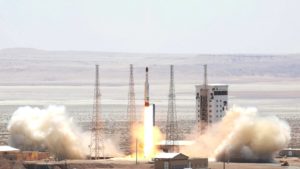
Iran’s test launch of its Simorgh space launch vehicle (SLV) on July 27, 2017, caused significant yet unsurprising controversy throughout the international community. Two months later, with the dust literally settling, Natalie Fuchs – SpaceWatch Middle East’s contributing editor on all things Iranian space – argues that it is possible that the U.S., its allies, and others such as China, were perhaps misplaced in their criticisms of the Simorgh SLV test launch.
On July 27, 2017 Iran launched its Simorgh space launch vehicle (SLV) from the Imam Khomeini Space Centre. The Simorgh (meaning Phoenix in Persian) has many implications, and the international community has, understandably, responded negatively to the launch. Despite their concerns, however, there is a case to be made that the launch might just be part of a genuine space programme. This Op-Ed examines the possibility that the Simorgh launch is merely a step in Iran’s plan to be an autonomous space-faring nation, as well as its security, economic, and cultural implications.
Touted as a success by Iranian new outlets, the international community’s concerns centre on the applicability of the showcased launch technology to that of ballistic missiles. Tehran couched the launch as the official inauguration of its Imam Khomeini Space Centre, the official site for all satellite-related operations located in the Semnam province of Iran. Statements by Javad Zarif, Iran’s foreign minister, in response to international disapproval express disappointment at the “bad faith” displayed by their punitive rhetoric and actions.
First among the Simorgh launch’s implications is, as previously stated, the probability that the launch technology can be applied to an intercontinental ballistic missile (ICBM). Though not directly in violation of U.N. Security Council Resolution (UNSCR) 2231, which calls upon Iran to not pursue missile technology capable of carrying a nuclear payload, the U.S., U.K., France, and Germany have collectively released a statement condemning the launch for its “inconsistency” with the Resolution. China’s ambassador to the U.N., Liu Jieyi, currently the president of the UN Security Council, also made a statement condemning Iranian actions as they relate to the Resolution. U.S. intelligence experts have said that the technology used for the launch can be used as a test bed for ICBMs, but there is still a long way for Iran to go in crafting indigenous, deployable ICBMs. According to experts, the Simorgh is still too small to even be a prototype of a rocket capable of carrying a nuclear payload.
Second, the launch represents an economic concern for Iran’s business partners. Liu Jieyi’s statement admonishing Iran for the launch was both an indication of wider international disapproval, as well as recognition that the success of the Simorgh launch indicates the beginning of decreased access to the Iranian satellite market for Beijing. Of the four Iranian satellites launched in previous years, two were carried out directly by the Chinese, and in 2008 Iran worked closely with China to design, manufacture, and launch a research satellite focused on cooperation on monitoring natural disasters – a regular occurrence in Iran.
Though the future of the Joint Comprehensive Plan of Action (JCPOA) remains uncertain given the current U.S. administration, the opening of Iranian markets as a result still represents an increasingly viable business opportunity for China. As Iran seeks to divest itself from Russia as a main trade partner, it has increasingly turned to China for other business ventures. Should Iran continue on its path of self-sufficient launch technology, the launch market for China will certainly diminish.
Third among the implications of the Simorgh launch is the potential for increased deployment of small satellites (Smallsats). The Simorgh SLV, according to statements by Iranian news outlet Tasnim, will be used for launching large-scale satellites. Though this is the explicit intent of the Simorgh, its ability to launch larger satellites also implies its potential to be used for Smallsats, which relative to the satellites Iran has planned for construction and launch, are inexpensive, and can serve many Iranian needs. With a track record of success launching an SLV for larger satellites, the space community should be prepared for the possibility of Iran leveraging Smallsat technology as well.
Finally, the launch serves to perpetuate the narrative of self-reliance crafted by the government in Tehran. Iran has historically used science and technology programmes to bolster the appearance to the international community that it is independent and should be taken seriously in standing among regional and global military powers. Though the Simorgh SLV itself is assessed to be based on North Korean technology, the test feeds into attempts to maintain that self-reliant image.
Though U.S. intelligence agencies have assessed the SLV did not carry a payload, its launch does hold many implications for the Iranian space programme moving forward. The Simorgh SLV is certainly a marked achievement for the Iranian space programme, and it cannot be denied the technology has the potential for military applications. Iran does, however, have a sizable amount of natural phenomena it needs to be able to monitor, and the development of indigenous launch capabilities makes sense in the context of a broader civil narrative. The international community must accept that while space technology could be tied with military activity, its development is not necessarily indicative of that end.
 SpaceWatch.Global An independent perspective on space
SpaceWatch.Global An independent perspective on space


